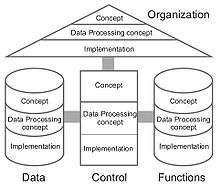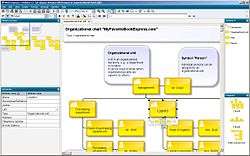Architecture of Integrated Information Systems

ARIS (Architecture of Integrated Information Systems) is an approach to enterprise modeling.[1] It offers methods for analyzing processes and taking a holistic view of process design, management, work flow, and application processing. The ARIS approach provides a generic methodological framework and a business process modeling tool.[2]
ARIS started as the academic research of August-Wilhelm Scheer in the 1990s. It has an industrial background and has sold very well globally.[1]
ARIS techniques
ARIS uses a modeling language known as Event-driven Process Chains (EPC), which is an important aspect of the ARIS-model. EPC is central to ARIS and connects all other views, as well as describing the dynamics of the business process.
Recent versions of the ARIS Toolset also support the Business Process Model and Notation (BPMN) in order to model business processes.
ARIS varies four main perspectives of techniques (see image):
- Organizational view
- Data view
- Control view
- Functional view
It differs from swim lane in that it is process-oriented whilst swim lanes are function-oriented. On the other hand, based on the conceptual description, ARIS can model and structure Business Process Models.
Furthermore, ARIS has been developed to implement business models in information systems.
Applications
As one of the Enterprise Modeling methods, ARIS provides four different aspects of applications:
- The ARIS concept
- is the architecture for describing business processes.
- provides modelling methods, the meta structures of which are comprised in information models.
- is the foundation for the ARIS Toolset software system for the support of modelling.
- The ARIS house of Business Engineering (HOBE) represents a concept for comprehensive computer-aided Business Process Management.
Examples
-

Example of ARIS Express
-

ARIS Express modelling
See also
- ARIS Express, free modeling tool by Software AG
- Architecture of Interoperable Information Systems
References
- 1 2 Marc Lankhorst (2005). Enterprise Architecture at Work: Modelling, Communication, and Analysis. Springer. ISBN 3-540-24371-2 p.35.
- ↑ Workflow Management within the ARIS Framework by Ted Williams
Further reading
- Ulrich Frank (2002) "Multi-Perspective Enterprise Modeling (MEMO) Conceptual Framework and Modeling Languages" Universität Koblenz-Landau; Rheinau 1, D-56075 Koblenz, Germany
- Thomas R. Gulledge and Rainer A. Sommer (1999) "Process Coupling in Business Process Engineering" George Mason University, USA. Knowledge and Process Management Volume 6 Number 3 pp 158–165
- Henk Jonkers, Marc Lankhorst, et al. (2004) "Concepts for Modeling Enterprise Architectures" Telematica Instituut, the Netherlands; University of Nijmegen, Nijmegen, the Netherlands; Leiden Institute for Advanced Computer Science, Leiden, the Netherlands; CWI, Amsterdam, the Netherlands
- August-Wilhelm Scheer, Markus Nüttgens "ARIS Architecture and Reference Models for Business Process Management" Institut für Wirtschaftsinformatik, Universität des Saarlandes, Im Stadtwald Geb. 14.1, D-66123 Saarbrücken
- August-Wilhelm Scheer (1996) "ARIS-Toolset:Von Forschungs-Prototypen zum Produkt" Informatik-Spektrum 19: 71–78 (1996) © Springer-Verlag 1996
External links
| Wikimedia Commons has media related to ARIS. |
- Software AG product page
- ARIS Community official ARIS community by Software AG
- From Event-driven modeling to Process monitoring. Presentation by Helge Hess, IDS Scheer, 2006.